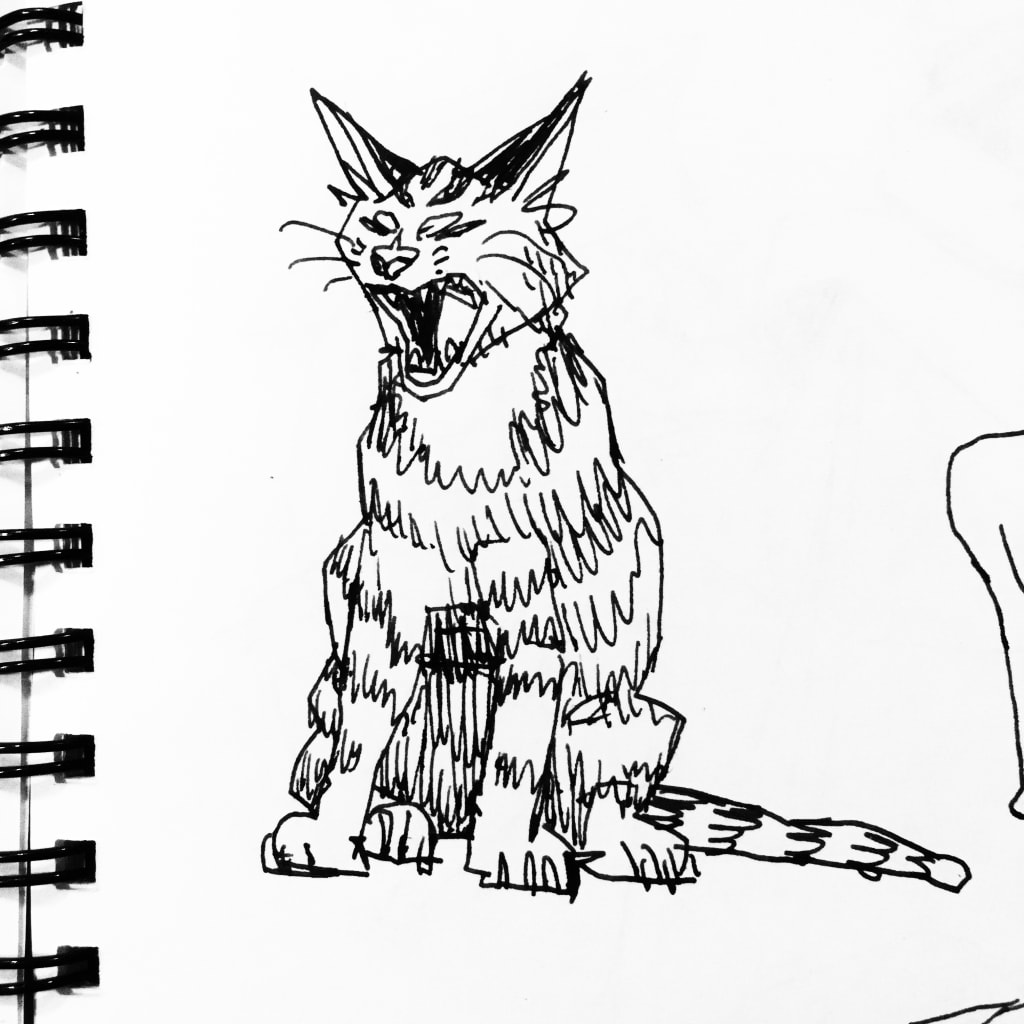Economy of Line

The identity of the figure in the drawing was not immediately apparent, but it was unquestionably erotic.
“That’s quite erotic,” said the Head of Collections.
“Unquestionably,” said the curator, nitrile gloved hands turning the delicate pages, animating a sequence of escalating indecency. The nude figure was drawn in pen and ink, a different pose filling the front and back of each page. In some cases, the figure was not completely nude, but the fishnets, leather straps, and various props (mainly vegetables), hid little.
The figures were fluid and graceful, drawn with an assured economy of line, even a certain carelessness, the likeness captured in four or five quick strokes. The strong line of the jaw, the droop of the eyelids, the half smile that was somehow more indecent than anything else in the little black book. The first twenty one pages were blank, except for an inscription on the reverse of the front cover: “J. F.”
It was the only text in the book—no date, no artist signature, no title to indicate the identity of the model. It wasn’t necessary. The figure, recumbent, leaning, kneeling, sometime on all fours, was unmistakably, unquestionably the late great star of stage and screen, Eli Spencer.
The identity of the artist was likewise obvious, both from the initials and the carefree mastery of the medium on display. The head of collections and the curator only had to confirm that this was the work of Jack Feldman, the famous painter.
“If it is an imitation, it’s an incredibly good one. See the way he draws the laces on this... is this a corset?”
“I believe it’s a harness actually,” said the Head of Collections. “Why are there so many blank pages at the beginning of the book?”
The curator scoffed. “Feldman was left-handed. Working from right to left helped prevent smears, though you can still see them from place to place.”
Indeed, several of the drawings were smudged, the pages smeared and splattered by various liquids, mostly but not exclusively red wine.
Leaning down to peer at a particular stain, the Head of Collections asked “Do you think we could get a DNA test done on this?”
The curator shook his head. “Feldman never had any children, and his studio was flooded in the nineties.”
“His grave?”
“He was cremated, unfortunately...”
The Head of Collections clicked her tongue at this mishandling of evidence and turned to look at the woman opposite. Paige Tolte sat patiently, staring out the window at the sycamores, their branches dancing in the breeze. Her attention was elsewhere, her mouth a polite smile. It was the expression of someone who knows the value of what they have, and is only waiting for the world to catch up.
The world caught up three days later, when the museum (small, generously endowed, and well regarded in the community) made the discovery public while simultaneously announcing a retrospective of John Feldman’s desinee work, of which they had a considerable collection, much of it unfortunately water damaged. The poster for the exhibition featured one of the uncovered sketches of Eli Spencer, known for his starring roles in “Guns for Hire,” (1974), “Western Burial,” (1966), “Jewel of the Savannah” (1967), “Cordelia’s Secret” (1971) and, most famously, 1974’s “Tyrant Rose,” the film that earned Spencer the Academy Award for Best Actor. It was awarded posthumously to his grieving widow, Spencer having been killed in a boating accident the previous June. The drawing in the poster was tastefully cropped, the studded leather collar just visible.
Spencer’s widow had died in 2003, but his son, Marcus, was very much alive and notoriously litigious. He appeared two days later on a popular cable news program to reiterate, red-faced and fuming, that the pictures were at best fan art made by a well known sexual deviant (he refused to use the word “artist” to describe an individual who was, in his opinion, little better than a men’s room graffiti scrawler, a purveyor of obscenity, a sicko). More likely, they were nothing but bad forgeries, commissioned by a cabal of bankers and their puny, worthless museum hoping to fool a credulous public and drive up the value of their so-called art. Marcus Spencer greatly resembled his father, and this resemblance, mixed with the whiff of sexual scandal and cagey anti-semitism, helped spread sound bites of the interview to every national network and several overseas. A libel lawsuit was filed by The Spencer Estate the same day, followed by a matching slander lawsuit from the museum, though perhaps it was the other way around.
Another libel suit was leveled at Paige Tolte, who had discovered the sketchbook tucked between a 50 pound box of expired encaustic and a copy of Johann Blythe’s “Feline Anatomy for Artists.” A liter of turpentine, illegally and inadvisably stored in a “Cafe Buscelo” can on the shelf above, had leaked and slightly damaged some of its pages—otherwise it was in excellent condition. Ms. Tolte has been looking for a box of oil pastels, which it would turn out had been stolen by one of the elderly students in her “Beginner Color Theory” class.
“I owe all my good fortune to that larcenous student!” Ms. Tolte would joke when interviewed on daytime television. She had an easy, husky laugh and the unflappability that only comes from thirty three years of teaching sculpture, oil painting, watercolor, pottery, fresco, figure drawing, lost-wax casting, and more to students of every age and temperament. When asked what she thought of the sketchbook, or how much the museum had compensated her, she’d laugh that husky laugh and say “I’m no expert, but the drawings were good! My nude figures certainly didn’t get this much attention.” Audiences were charmed by her obvious good nature and preference for homemade jumpsuits stamped with bold floral patterns. The judge in Marcus Spencer’s libel suit took one look at defendant Tolte and dismissed the charges of libel and slander immediately. She had sewn a new jumpsuit from plain black canvas and was slightly disappointed in the quick decision.
The relationship between Eli Spencer and Jack Feldman had always been a topic of interest, and the sketchbook’s discovery only confirmed a widely held impression. Marcus Spencer continued to defend his father’s virtuous American heterosexuality, popping up now and then to sue a journalist, a critic, the producer of the incredibly popular documentary “J. F.” (2021), and Ms. Tolte, again. The poster for the documentary was a cropped picture of Spencer and Feldman, smoking cigars and laughing aboard Spencer’s yacht, “Ganymede.”
Paige Tolte, in a striking black jumpsuit stamped with small white chrysanthemums, stood near the third story window of Tolte Academy, an enormous cup of ginger tea steaming between her hands. Peering through the leaded windows, the old sycamore’s branches dancing in the breeze, she reflected on the merits of a life well lived, and the benefits of acquiring and polishing a wide range of artistic skills.
About the Creator
Jonathan Tune
I live on a boat in Seattle.
Enjoyed the story? Support the Creator.
Subscribe for free to receive all their stories in your feed. You could also pledge your support or give them a one-off tip, letting them know you appreciate their work.





Comments
There are no comments for this story
Be the first to respond and start the conversation.